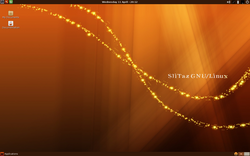SliTaz
| Developer | The SliTaz GNU/Linux Association Christophe Lincoln |
|---|---|
| OS family | Unix-like |
| Working state | Current |
| Source model | Open source |
| Initial release | 22 March 2008 |
| Latest release | (Rolling Release) / February 19, 2017 |
| Package manager | Tazpkg |
| Platforms | x86 x64 |
| Kernel type | Monolithic (Linux kernel) |
| Default user interface | Openbox, LXDE |
| License | GNU GPL and various others |
| Official website | slitaz |
SliTaz GNU/Linux is a lightweight GNU/Linux distribution, community-based, suitable for use on older hardware and as a Live CD or Live USB. The name SliTaz stands for "Simple Light Incredible Temporary Autonomous Zone".
SliTaz uses the Openbox window manager.
Additional packages are added using a program called "TazPanel". This is due to the specific package format that SliTaz uses (tazpkg). It can still use packages from the more popular distribution though, as Debian, by means of first carrying out a conversion of these different packages.
By default, SliTaz offers no persistence, however it can still be added if the user wishes. The choice of the filesystem/bootloader used with slitaz is then of importance however; persistence being only available with ext2 and ext3 filesystems and the syslinux or extlinux boot loader.
Another useful tool is TazLiTo, with which users can create their own LiveCD based on selected packages or even based upon the current system state.
SliTaz GNU/Linux is supported on all machines based on the i486 or x86 Intel compatible processors. The Live CD has four variants of SliTaz, requiring from 192 MB of RAM for the Core system to 48 MB for a text mode and X Window System.
SliTaz can even run in 16 MB of RAM and a little swap memory. SliTaz can be booted from a Live CD, Live USB, floppy disk, or a local area network (PXE), or can be installed, requiring approximately 80 MB of hard disk space.
...
Wikipedia


